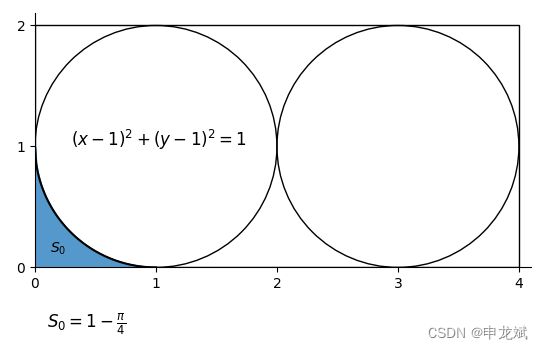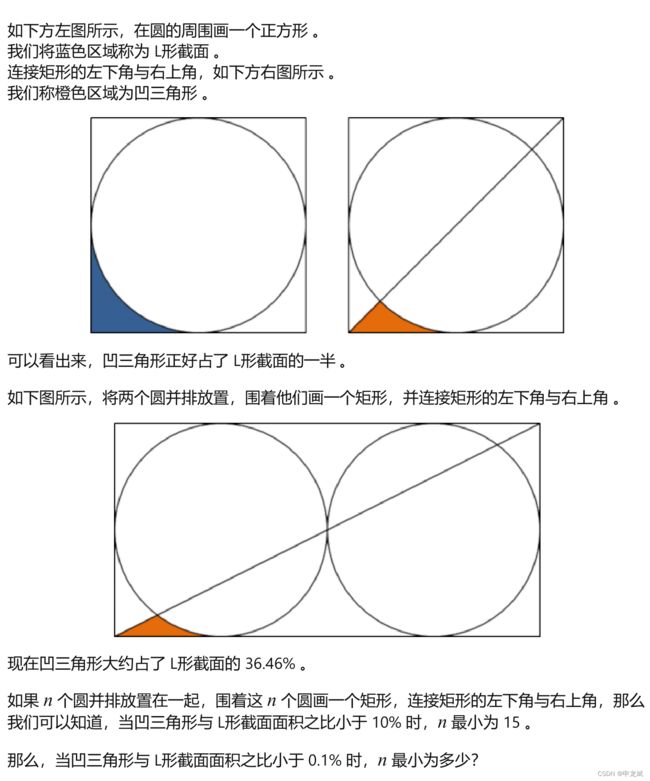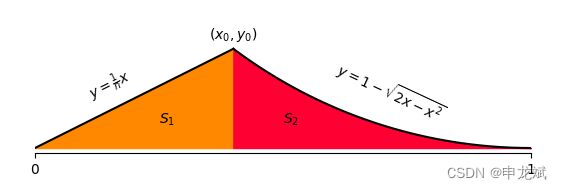详解欧拉计划之第587题:凹三角形
不妨假设圆的半径为1。
第一步,先计算出L形截面的面积
L形截面相当于正方形里抠掉1/4个圆。
S 0 = 1 − π 4 S_0=1 - \frac{\pi}{4} S0=1−4π

画上面的这个图,用到了matplotlib的python代码,也一并贴出来供参考。
import numpy as np
import matplotlib.pyplot as plt
fig, ax = plt.subplots()
# 保持纵横比,这样圆不会画成一个椭圆
ax.set_aspect('equal')
# 不显示上面和右面的边框线
ax.spines[['top', 'right']].set_visible(False)
# 画2个圆
circle1 = plt.Circle((1, 1), 1, edgecolor='black', fill=False)
ax.add_patch(circle1)
circle2 = plt.Circle((3, 1), 1, edgecolor='black', fill=False)
ax.add_patch(circle2)
# 画包围2个圆的矩形
ax.add_patch(plt.Rectangle((0, 0), 4, 2, edgecolor='black', fill=False))
# 左下角L形区域
x = np.linspace(0, 1, 100)
y = 1 - np.sqrt(2*x - x*x)
ax.plot(x, y, color='black')
ax.fill_between(x, y, color='#5599cc')
ax.text(0.12, 0.12, r'$S_0$')
ax.text(0.1, -0.5, r'$S_0=1 - \frac{\pi}{4}$', size='12')
ax.text(0.3, 1, r'$(x-1)^2+(y-1)^2=1$', size='12')
#ax.plot([0, 4], [0, 2], 'black', linewidth=1)
ax.set_xlim(0, 4.1)
ax.set_xticks(range(0, 5))
ax.set_ylim(0, 2.1)
ax.set_yticks(range(0, 3))
fig.show()
第二步,计算凹三角形的面积
设n为圆的个数,当n=2时,用matplotlib绘出来的图,凹三角形如下所示。

相应的python绘图代码:
import numpy as np
import matplotlib.pyplot as plt
fig, ax = plt.subplots()
# 保持纵横比,这样圆不会画成一个椭圆
ax.set_aspect('equal')
# 不显示上面和右面的边框线
ax.spines[['top', 'right']].set_visible(False)
# 画2个圆
circle1 = plt.Circle((1, 1), 1, edgecolor='black', fill=False)
ax.add_patch(circle1)
circle2 = plt.Circle((3, 1), 1, edgecolor='black', fill=False)
ax.add_patch(circle2)
# 画包围2个圆的矩形
ax.add_patch(plt.Rectangle((0, 0), 4, 2, edgecolor='black', fill=False))
# 左下角凹三角形区域,分2部分画出
x = np.linspace(0, 0.4, 100)
y = 0.5 * x
ax.plot(x, y, color='black')
ax.fill_between(x, y, color='r')
x = np.linspace(0.4, 1, 100)
y = 1 - np.sqrt(2 * x - x * x)
ax.plot(x, y, color='black')
ax.fill_between(x, y, color='r')
# 画(0, 0) 到 右上角的连线
ax.plot([0, 4], [0, 2], 'black', linewidth=1)
ax.set_xlim(0, 4.1)
ax.set_xticks(range(0, 5))
ax.set_ylim(0, 2.1)
ax.set_yticks(range(0, 3))
fig.show()
把凹三角形那个图像放大一些仔细研究,可以看出它有2部分组成,左侧是一个直角三角形,右侧是一段圆弧与x轴围出的一块区域,直线和曲线的方程用到一点点解析几何的知识,如下图。
import numpy as np
import matplotlib.pyplot as plt
fig, ax = plt.subplots()
# 保持纵横比,这样圆不会画成一个椭圆
ax.set_aspect('equal')
# 不显示上面和右面的边框线
ax.spines[['left', 'top', 'right']].set_visible(False)
# 左下角凹三角形区域,分2部分S1、S2画出
x = np.linspace(0, 0.4, 100)
y = 0.5 * x
ax.plot(x, y, color='black')
ax.fill_between(x, y, color='#FF8800')
ax.text(0.25, 0.05, r'$S_1$')
ax.text(0.1, 0.1, r'$y = \frac{1}{n} x$', rotation=26.5)
x = np.linspace(0.4, 1, 100)
y = 1 - np.sqrt(2 * x - x * x)
ax.plot(x, y, color='black')
ax.fill_between(x, y, color='#FF0033')
ax.text(0.5, 0.05, r'$S_2$')
ax.text(0.6, 0.05, r'$y = 1 - \sqrt{2x - x^2}$', rotation=-25)
ax.text(0.35, 0.22, r'$(x_0, y_0)$')
ax.set_xlim(0, 1)
ax.set_xticks([0, 1])
ax.set_yticks([])
fig.show()
凹三角形的面积等于S1与S2之和。要计算出这两个面积,关键在于计算出交点(x0, y0)的坐标。
交点坐标,就是求解下面这个方程组的解:
y = 1 n x y = \frac{1}{n} x y=n1x
y = 1 − 2 x − x 2 y = 1 - \sqrt{2x-x^2} y=1−2x−x2
利用高中知识,可以得到解:
x 0 = n y 0 = n ( n + 1 − 2 n ) n 2 + 1 x_0 = ny_0 = \frac {n(n + 1 - \sqrt{2n})}{n^2 + 1} x0=ny0=n2+1n(n+1−2n)
y 0 = n + 1 − 2 n n 2 + 1 y_0 = \frac {n + 1 - \sqrt{2n}}{n^2 + 1} y0=n2+1n+1−2n
S1是个直角三角形,很容易计算出来:
S 1 = 1 2 x 0 y 0 S_1 = \frac {1}{2}x_0y_0 S1=21x0y0
S2则需要计算一个定积分:
公式的LaTeX代码:
$S_2= \int _{x_0}^1 {(1 - \sqrt{2x-x^2})}dx$
求曲线与x轴围成的面积,有一个simpson求定积分的近似算法:
def simpsons(func, lower, upper, n):
step = (upper - lower) / n
x = [lower + i * step for i in range(n + 1)]
res = 0
for i in range(n+1):
yi = func(x[i])
if i == 0 or i == n:
res += yi
elif i % 2 != 0:
res += 4 * yi
else:
res += 2 * yi
res *= step / 3
return res
第三步,编程求解
n越大,面积比越小,只需循环求解即可。
import math
# 凹三角形与L形截面的面积比
def area_percent(n):
s0 = 1 - math.pi / 4
y0 = (n + 1 - math.sqrt(2*n)) / (n * n + 1)
x0 = n * y0
s1 = 0.5 * x0 * y0
fx = lambda x : 1 - math.sqrt(2*x-x*x)
s2 = simpsons(fx, x0, 1.0, 100)
percent = (s1 + s2) / s0
return percent
def min_n(percent):
n = 1
while area_percent(n) >= percent:
n += 1
print(f'面积比小于:{percent:6.2%},n最小为{n}')
return n
assert round(area_percent(2), 4) == 0.3646
assert min_n(0.1) == 15
min_n(0.001)
最后的答案是:2240
积分公式
如果有更多的大学数学知识,或者用mathmatica等工具,还可以直接把S2那个积分公式计算出来:
1 − x 2 2 x − x 2 + x + sin − 1 ( 1 − x 2 ) + C \frac{1-x}{2} \sqrt{2x - x^2} + x + \sin^{-1}(\sqrt{1-\frac x 2})+C 21−x2x−x2+x+sin−1(1−2x)+C
这样不用simpson积分,也可以计算出面积S2。
# 凹三角形与L形截面的面积比
def area_percent(n):
s0 = 1 - math.pi / 4
y0 = (n + 1 - math.sqrt(2*n)) / (n * n + 1)
x0 = n * y0
s1 = 0.5 * x0 * y0
int_fx = lambda x: math.sqrt(2*x - x*x) * (1-x) / 2 + x + math.asin(math.sqrt(1-x/2))
s2 = int_fx(1) - int_fx(x0)
percent = (s1 + s2) / s0
return percent


